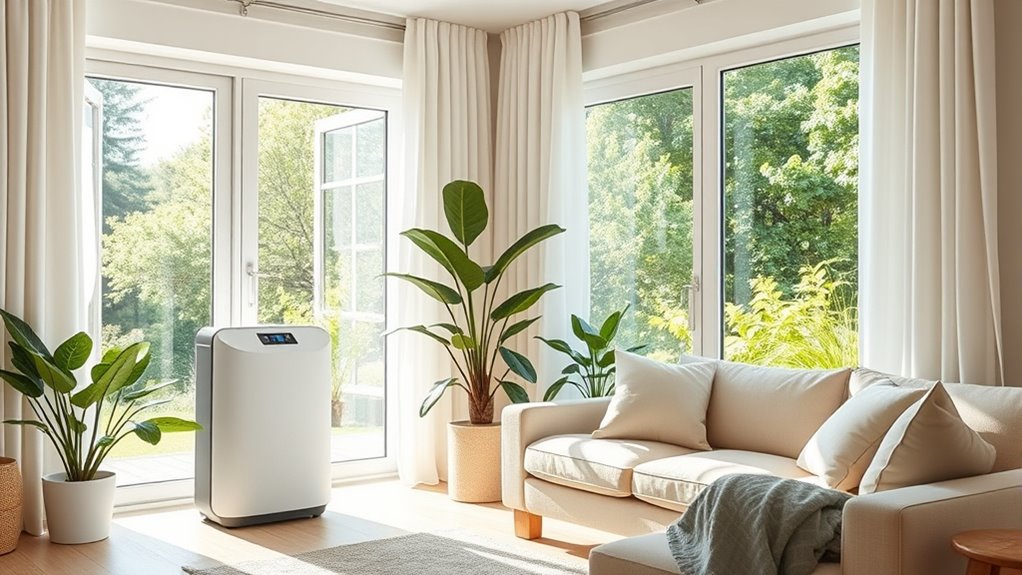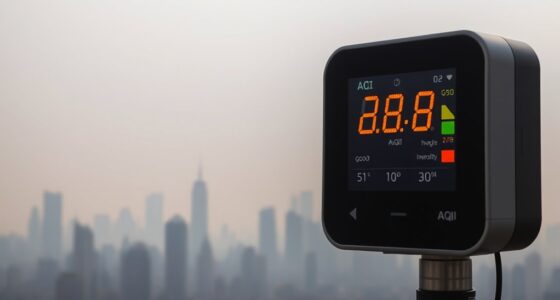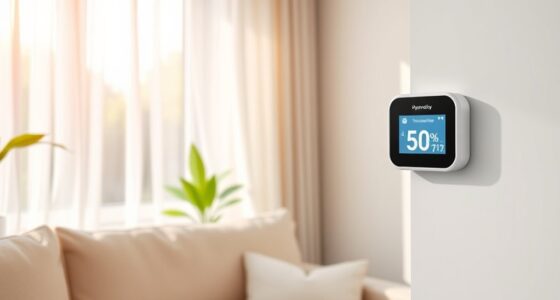To better manage allergies, focus on improving your indoor air quality by using air purifiers with HEPA filters, which can trap allergens like dust, pollen, and pet dander. Regularly test your indoor air to identify hidden pollutants and adjust your filtration systems accordingly. Keeping your home clean and controlling humidity levels also help reduce mold and dust buildup. Staying proactive with these strategies can create a healthier environment—discover more ways to breathe easier as you continue.
Key Takeaways
- Use air purifiers with HEPA filters to remove common allergens like dust, pollen, and pet dander.
- Conduct indoor air testing to identify specific allergens and pollutants affecting your home.
- Combine air quality monitoring with targeted filtration to address mold, moisture, and other triggers.
- Maintain regular cleaning and humidity control to reduce allergen buildup and improve air quality.
- Continuously monitor indoor air and adjust purification strategies for ongoing allergy symptom relief.

If you suffer from allergies, improving your indoor air quality can make a substantial difference in managing your symptoms. One effective way to do this is by understanding the benefits of air purifiers. Air purifier benefits go beyond just removing dust; they can considerably reduce airborne allergens like pollen, pet dander, mold spores, and even airborne bacteria. When you run an air purifier consistently, you create a cleaner environment that minimizes allergen exposure, often resulting in fewer allergy attacks and improved breathing. Choosing the right air purifier involves considering factors like HEPA filters, which trap tiny particles, and ensuring the unit is appropriately sized for your space. But to truly optimize your indoor air quality, you need to know what’s lurking in your environment. That’s where indoor air testing comes into play. Indoor air testing helps identify specific allergens and pollutants present in your home, giving you targeted insights into what might be triggering your allergies. For example, if testing reveals high mold spore levels, you can take steps to reduce moisture and improve ventilation. Knowing the precise composition of your indoor air allows you to make informed decisions about treatment and prevention strategies. Many people overlook the importance of testing, assuming that all indoor air is equally safe, but that’s rarely the case. With accurate results from indoor air testing, you can pinpoint problem areas and address them directly, whether that means upgrading your filtration system, cleaning more frequently, or addressing sources of mold or dust. Combining this knowledge with an effective air purifier creates a powerful defense against allergens, especially during peak allergy seasons. Additionally, some air purifiers come with sensors that monitor indoor air quality in real-time, alerting you when pollutant levels spike so you can take immediate action. This proactive approach helps prevent allergy symptoms from worsening. Remember, the key is consistency—running your air purifier daily and regularly testing your indoor air ensures you’re always aware of your environment’s health. Making these improvements can also contribute to better overall health, reducing respiratory irritation and enhancing sleep quality. Maintaining a clean home, controlling humidity levels, and investing in quality air filtration systems based on indoor air testing results can substantially improve your quality of life. The more you understand about your indoor environment, the better equipped you’ll be to manage your allergies effectively. By integrating air purifier benefits with targeted testing, you’ll create a healthier, more comfortable space that supports your well-being all year round. Understanding indoor air quality and its impact is crucial for allergy management.
Frequently Asked Questions
Can Air Purifiers Completely Eliminate All Allergy Triggers?
Air purifiers can’t completely eliminate all allergy triggers because of their limitations. They effectively remove many airborne particles like pollen, pet dander, and dust mites, but can’t target allergen sources like mold growth or indoor plants. Plus, some triggers settle on surfaces or are carried in through open windows. To reduce allergies, use an air purifier alongside cleaning, controlling humidity, and minimizing trigger sources for the best results.
How Often Should I Replace or Clean Air Filters for Allergy Relief?
Think of your air filter as the gatekeeper of fresh air; if it’s clogged, allergens sneak through. You should replace or clean your air filters every 1 to 3 months for ideal filter maintenance and allergy relief. Regular upkeep keeps your indoor air crisp and clean, preventing allergens from building up and ensuring your air purifier works at peak performance. Stay vigilant, and breathe easier every day.
Do Plants Help Improve Indoor Air Quality for Allergy Sufferers?
Indoor plants can help improve air quality and support allergy reduction, but they aren’t a cure-all. Some plants filter out toxins and increase humidity, which may ease allergy symptoms. However, be cautious because certain plants can produce pollen or mold that worsen allergies. Choose low-pollen, mold-resistant indoor plants like snake plants or pothos, and keep them clean to maximize their benefits for allergy sufferers.
Are There Specific Air Quality Levels That Significantly Reduce Allergy Symptoms?
You can substantially reduce allergy symptoms by maintaining air quality levels below established standards and allergy symptom thresholds. Aim for an air quality index (AQI) of 50 or lower, as this minimizes airborne allergens. Use air purifiers with HEPA filters, guarantee proper ventilation, and regularly clean your space. Keeping indoor air clean and within safe levels helps lessen allergy triggers, making it easier for you to breathe comfortably.
How Does Humidity Control Affect Indoor Allergy Management?
Imagine turning down the volume on indoor allergens—humidity regulation plays a vital role. By maintaining ideal humidity levels, you can prevent mold growth and reduce dust mites, making your environment more comfortable. Proper humidity control helps keep mold at bay, which is essential for allergy sufferers. When you regulate humidity effectively, you create a healthier indoor space, easing allergy symptoms and promoting overall well-being.
Conclusion
By focusing on improving your indoor air quality, you can greatly reduce allergy symptoms and breathe easier. Did you know that indoor air pollution can be up to five times higher than outdoor levels? Taking simple steps like using air purifiers, maintaining proper ventilation, and avoiding allergens can make a big difference. Start today—better air means better health, so you can enjoy your home without the constant struggle of allergies.









